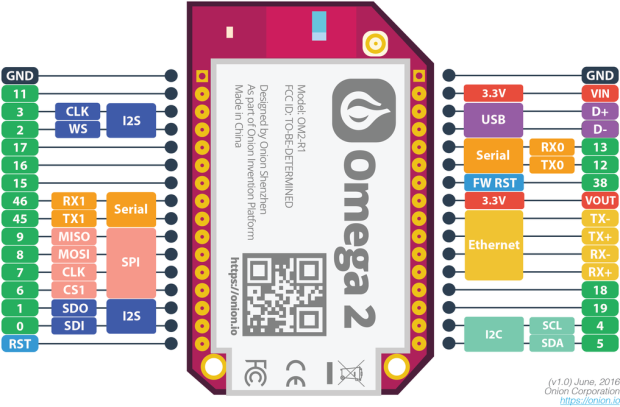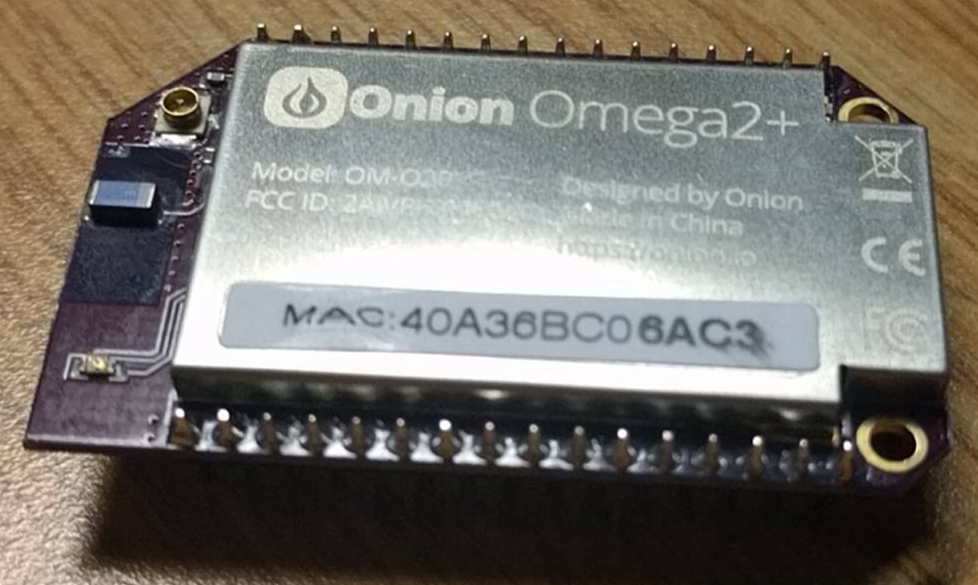USB connection without a dock
-
I noticed on the pinout diagram for the omega 2/2+ that the first four pins are the same as a USB pinout (V+, GND, D+, D-), and I was wondering if I could just solder the ends of a stripped USB cable to those pins and use it without any extra gadgetry (notwithstanding a voltage regulator to drop USB's 5V to the 3V3 required), or do I need some sort of TTL converter to make it work?

-
To my knowledge, the schematics are not released yet. Since you received your Omega2, it would be safer for you to trace the relevant pins on your Omega2 PCB to find out their characteristics, and determine what is missing to complete the USB circuit. Btw, the above diagram is for the Omega v1.0. Some little changes are expected for the Omega2.
-
I found this while looking at the datasheet for the AR3991:

So it seems to me it would be fine...
(Also, did you miss the part of the diagram that says "Omega 2" on it? ;-))
-
@Alex-Brooke said in USB connection without a dock:
(Also, did you miss the part of the diagram that says "Omega 2" on it? ;-))
I know! It's kind of confusing. Onion did that on purpose for the Omega2 label for the Kickstarter campaign, but actually used the Omega1 pinout. If I recall, they clarified this fact either in this forum or in the Kickstarter comments. What is important is the revision number in small prints on the lower right. Always read the small prints.

-
@fossette yeah, I figured the revision 1.0 label was referring to it being the first revision of the diagram for the omega 2

Also unfortunately there is a large metal box covering the SOC and stuff (as in the diagram above) so it's basically impossible to follow the traces to the chip.
-
To my knowledge, the schematics are not released yet
Yeah, this is the problem. Onion have sent us a board we cannot use, and aren't giving any word on when this info might be available. Come on!
-
Well anyway, as soon as I get home for the holidays I'll start testing my theory, though it would be nice to have an official answer.
-
@Fred-Rauch said in USB connection without a dock:
Onion have sent us a board we cannot use
Speak for yourself!
 Lol!!! I'm pretty convinced that when I receive my Omega2, I'll be able to use it without reading a single line of any accompanying doc. (And if I screw-up, I have a backup module.)
Lol!!! I'm pretty convinced that when I receive my Omega2, I'll be able to use it without reading a single line of any accompanying doc. (And if I screw-up, I have a backup module.)Honestly, Omega2 is based on the Omega. There's lots of docs out there to provide some hints. Also, the CPU chipset docs are your best friend. If you can trace an Omega pin to a documented CPU pin, you're in business.
-
@fossette said in USB connection without a dock:
If you can trace an Omega pin to a documented CPU pin, you're in business.
Remember there's a big metal plate covering one whole side of the board (the side with the ICs
 )
)

EDIT: wow that's a big picture
-
@Alex-Brooke said in USB connection without a dock:
EDIT: wow that's a big picture!
There is software to resize big ones...
Btw, this baby's name is Omega2 +, Onion is the company behind.
-
The first Omega2+ photo Yeah for that!
 Yes, that metal plate is a party pooper...
Yes, that metal plate is a party pooper...  Onion will need to release those schematics...
Onion will need to release those schematics...
-
Just approach the problem from the other side: The Omega2 is compatible with all Onion1's docks. And the schematics of the docks and relevant expansions such as Ethernet are all available here.
So it's quite easy to see (on the second page) what's needed to use the USB Host port of an Omega (1 or 2): no active level shifters, but preferably some ESD protection diodes. And, as the original poster said, of course the USB V+ is 5V and must not be connected to 3.3V.
You can also see that the Micro USB port of the dock is not connected directly to the Omega USB pins, but to a USB-to-serial converter chip, which in turn is connected to RX0/TX0, giving access to the console.
So one way to access an Omega without any dock is using a USB-Serial cable with enough 3.3V power (>200mA), such as the FTDI TTL-232RG-VREG3V3-WE, and connect it to power and RX0/TX0.
@Alex-Brooke the Omega2 is not based on the AR9331 any more, but uses the MediaTek MT7688 (official datasheet available)
-
@luz I know that it's possible to use a serial to USB converter-- my question was whether I can connect directly over USB without any extra hardware.
Good to know about the MT6788 though, thanks.@Luciano-S. said in USB connection without a dock:
@Alex-Brooke said in USB connection without a dock:
EDIT: wow that's a big picture!
There is software to resize big ones...
Btw, this baby's name is Omega2 +, Onion is the company behind.I know there's software to resize photos, and also I know what this board is and who made it. After all, I bought the jeezless thing
-
@Alex-Brooke said in USB connection without a dock:
@luz I know that it's possible to use a serial to USB converter-- my question was whether I can connect directly over USB without any extra hardware.
As said, on the hardware level you can. But it's USB host, because the Omega uses its native USB port to allow connecting extras such as the GPS extension, USB drives etc.
Your original question sounded like you wanted to get access to the linux console, and for that the answer is no, because the Omega firmware is configured to provide console access via the serial port only.
Maybe it is possible to use the Omega USB PHY in device mode, but that would require compiling or even porting kernel modules (kmod-usb-gadget), building custom firmware images etc. Nothing even in the proximity of "quickly making things work"

-
@luz I just found out that USB OTG converters tell the device they're connected to to act as a host by pulling the ID pin to ground. Would this work for an Omega board, or would there still have to be firmware-level support for that, as you suggested?
-
@Alex-Brooke said in USB connection without a dock:
I noticed on the pinout diagram for the omega 2/2+ that the first four pins are the same as a USB pinout (V+, GND, D+, D-), and I was wondering if I could just solder the ends of a stripped USB cable to those pins and use it without any extra gadgetry (notwithstanding a voltage regulator to drop USB's 5V to the 3V3 required), or do I need some sort of TTL converter to make it work?

I just tried this, and the answer is yes!
-
Hm, this is odd. I tried soldering the wires from a USB-Serial converter to the relevant pins on my omega, and it didn't seem to boot (at least, the light didn't come on and as far as I could tell, no wireless network was broadcast). I even tried plugging it into the wall to see if my computer was supplying an insufficient current, but I got no dice there either.
Unfortunately, I don't have a multimeter around to test actual values.EDIT: I spoke too soon! Turns out I soldered the power wires to the wrong pins >__<
-
@Fred-Rauch the question was:
"I noticed on the pinout diagram for the omega 2/2+ that the first four pins are the same as a USB pinout (V+, GND, D+, D-), and I was wondering if I could just solder the ends of a stripped USB cable to those pins and use it without any extra gadgetry (notwithstanding a voltage regulator to drop USB's 5V to the 3V3 required), or do I need some sort of TTL converter to make it work?"I understood: if you connect the USB header pins to a USB connector, it works like the dock?
You answered YES, for it work without any other component or... YES for needing TTL converter?
-
There is no applicable meaning of a "TTL converter" to USB.
Although VBUS is 5v, USB does not use "TTL" signalling, but rather lower voltage differential signalling.
Some USB capable chip's vendors do recommend series resistors for matching, and some boards have ESD components. But if you look at the published schematics for Mediatek's comparable module for the MT7688, the USB data lines go straight from the connector to the MT7688 pins.
-
So what is the "final" answer:
you can just solder wires from a regular USB (B) plug to the USB D+, D-, V and Gnd pins on Omega2; then treat the USB pins on Omega2 as a USB host (A) port that can output 5V to the USB plug, and send/receive data on the D pins?I am thinking of connecting a USB webcam to the Omega2 this way to stream video from the cam via Omega2 WiFi. Hopefully then I will only need a 3.3V PSU for the Omega2 ( maybe LiFE PO4 ) while the cam is powered by the Omega2 USB host port?
-
@Athar-Mian Yes, the Omega's USB D+, D-, Gnd and 5V+ pins will work to power and work with a USB webcam, but you can't expect the Omega's 5V+ pin to supply that required 5V to the camera if you power the Omega with 3.3V. Either use a 5V USB power source [with a Mini Dock] at the Omega's micro USB socket, or perhaps a DC-DC step-up board to convert the 3.3V source to 5V [for the web cam].
[edited 2-22-17 to reflect the fact that this thread is about powering an Omega without a dock]